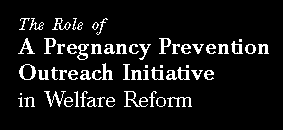

![]()
For the Full Version of this Document, including the Appendix with Examples of Innovative Pregnancy Prevention Outreach Initiatives, click here.
Introduction to the Summary
The issues of pregnancy prevention and welfare reform are closely linked. Increasing voluntary participation in family planning services is a key element in any effective strategy to reform the welfare system. Preventing subsequent pregnancies on the part of current welfare recipients, as well as unintended pregnancies among low-income adults and teenagers who are not currently receiving welfare, is essential if the nation is to reduce reliance on AFDC and other assistance programs.
Welfare reform legislation must include new pregnancy prevention outreach and marketing initiatives that extend to hard-to-reach populations at risk and increase the utilization of existing family planning clinical services by these populations. Yet new pregnancy prevention outreach initiatives and increased utilization of family planning clinical services by these populations will not alone solve the problems of poverty and of the welfare system. More job opportunities, increased educational opportunities, as well as the expansion of child care and access to health care are also essential elements of an effective welfare reform strategy.
Poverty, Welfare, and Unintended Pregnancy Prevention: The Links
How does unintended pregnancy among low-income women and teenagers affect the welfare system? Cases involving births to women out of wedlock accounted for 80 percent of the 1.1 million growth in the welfare rolls over the past decade. Unintended pregnancy and childbirth among teenagers is an especially significant issue for welfare reform efforts: 82 percent of all teen pregnancies are unintended; nearly half of teen mothers are on welfare within five years. Just 70 percent of women who were teen parents finish high school by their late 30s. Almost 80 percent of the children of those teens who have had a child out-of-wedlock before high school graduation live in poverty.
Welfare reform measures alone, without new initiatives to prevent unintended pregnancy, will not sufficiently solve these significant problems -- problems that affect government spending, the nation's quality of life, and its economic future. There is no evidence which suggests that welfare reform, without encouraging pregnancy prevention, would create change in sexual practices: while the out-of-wedlock birthrate among the poor doubled from 1979-92, it also doubled among those who were not poor. The denial of welfare payments to low-income women and adolescents may motivate some of them not to have children. However, for those who choose not to abstain from sexual activity, unimpeded access to and effective use of contraceptives is the only way that they will be able to avoid pregnancy.
The Need To Expand Pregnancy Prevention Outreach Initiatives
While some innovative, successful pregnancy prevention outreach and family planning marketing/promotion programs aimed at these populations exist across the nation, funding for such efforts usually has been short-term and/or insufficient to produce significant results on a large scale. These efforts do not reach large sectors of the population -- especially many of those who are on AFDC, or who are low-income women or teenagers at risk for unintended pregnancy. Yet they could serve as models for a more ambitious, nationwide outreach initiative.
A Pregnancy Prevention Outreach Initiative Should Be Part of Federal Welfare Reform
Federal welfare reform legislation should include a requirement that states use a portion of any federal funding made available under such legislation for pregnancy prevention outreach initiatives. Yet it should allow states the flexibility to design and implement appropriate programs. It should also stipulate that participation in pregnancy prevention initiatives or in family planning services should be strictly voluntary and not a condition of receiving any government benefits.
A Pregnancy Prevention Outreach Component of Welfare Reform:
To Disseminate Information, Promote Personal Responsibility, and Increase Voluntary Participation in Family Planning Services
The goal of this proposed program is to reduce the rate of pregnancy among those now participating in AFDC as well as among those low-income women and teenagers for whom a pregnancy now, given their current economic and social circumstances, would likely result in AFDC enrollment.
Meeting this goal would result in benefits to individuals within the target population affected (including reduced obstacles to employment/educational opportunities and increased prospects for a healthier and better quality of life). It would also pay dividends to government and taxpayers (reduced expenditures for welfare, health care, child care, and social services).
The objectives of this program are:
The Target Populations Two Categories
Pregnancy Prevention Outreach Program Options
Paying The Costs of The Initiative
In subsequent years of this program, effective outreach to at-risk populations and increased participation in existing family planning services by these populations will have reduced the number of unintended births, and, consequently, will have significantly reduced government expenditures on AFDC, Medicaid, Food Stamps, and other social support services. These savings should more than pay for the initiatives, since increased utilization of family planning services can reduce the need for other medical expenditures and social services costs.
Endorsed and issued by:
Family Planning Councils of America
The National Family Planning and Reproductive Health Association
February 1995
Return to FPCA Public Policy Papers Cover
